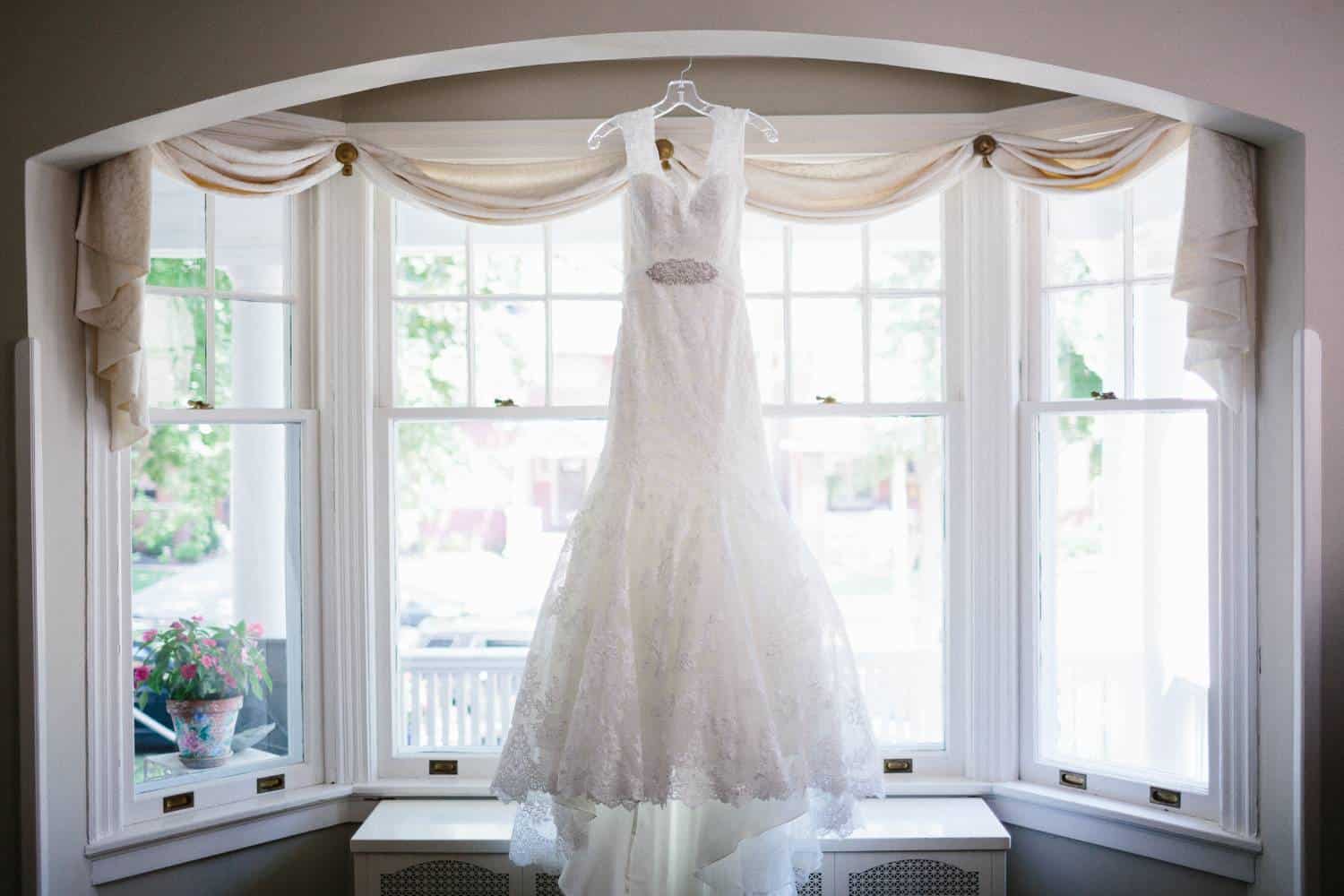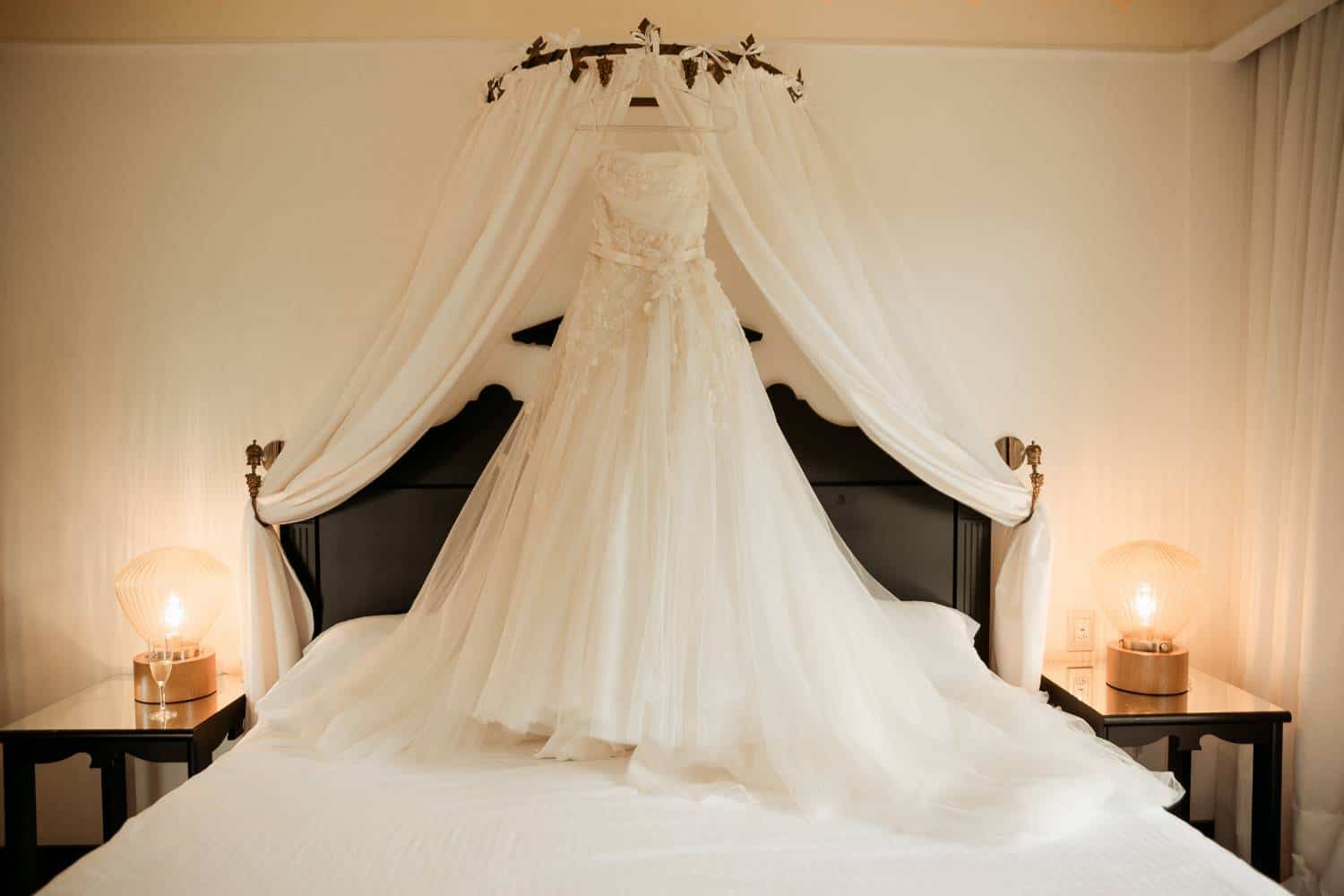Your wedding day is one of the most memorable moments of your life, and your gown plays a huge part in that special occasion.
However, many brides are concerned about whether their cherished dress will stand the test of time or succumb to yellowing.
Wedding dresses, particularly those made from delicate materials, are prone to yellowing as time passes. But don’t worry!
With proper care and preservation, you can slow down the aging process and keep your gown looking as beautiful as the day you wore it.
In this blog, we’ll explore the reasons behind dress yellowing, what steps you can take to prevent it, and how to restore a yellowed gown to its former glory.
Let’s get straight to the point
Wedding dresses can turn yellow over time due to natural fabric degradation, exposure to pollutants, and hidden stains that resurface.
Storing a dress in plastic garment bags can cause “phenolic yellowing.” To slow the process, brides should use professional preservation services, avoid plastic storage, and keep dresses in cool, dry, and dark environments.
If yellowing occurs, professional restoration can often reverse the damage, though not all stains may be fully removed. Acting quickly is key to preserving the gown and its memories for future generations.
Why Do Wedding Dresses Turn Yellow?
It’s not just an old wives’ tale – wedding dresses do turn yellow over time. The yellowing occurs due to a combination of environmental factors and the natural deterioration of the fabric fibres.
Even with careful storage, such as placing your gown in a plastic garment bag, you can’t completely stop the yellowing process.
This phenomenon, called phenolic yellowing, happens when the chemicals in the plastic bag and the fabric interact, causing the material to turn yellow.
Degradation of Natural Fibres
Many wedding gowns are made from natural fibres, such as silk, satin, and lace.
Over time, these materials are highly susceptible to yellowing because they naturally break down when exposed to sunlight, humidity, and heat.
While you may have taken great care to preserve your dress, these factors can slowly cause the fabric to age and yellow.
The Role of Atmospheric Pollutants
Atmospheric pollutants, such as nitrogen and industrial emissions, can also contribute to the yellowing of fabrics. If you live in an urban area, your dress is more likely to be exposed to air pollution.
These pollutants can settle on the surface of your dress, and while the yellowing may appear subtle at first, it will become more noticeable over time.
Hidden Stains That Resurface
Another major culprit behind yellowing wedding dresses is invisible stains. After your wedding day, your gown may have picked up stains from sweat, perfume, makeup, food, or drink.
Even if these stains weren’t visible at the time, they can resurface years later as they oxidise, turning brown or yellow. This can be especially heartbreaking for brides who thought their dresses were clean and pristine.
Can You Prevent Your Dress From Turning Yellow?
The good news is that while you can’t completely stop the yellowing process, there are steps you can take to significantly slow it down.
Proper wedding dress preservation is essential to ensuring your gown remains in the best possible condition.
Professional Preservation Services
Your best option to prevent yellowing is to invest in professional wedding dress preservation.
These services use specialised techniques to clean and store your dress in an environment that minimises exposure to harmful elements like heat, humidity, and pollutants.
Most professional preservation services in Australia will also use acid-free tissue paper and a storage box designed to prevent contamination from the environment.
Avoid Storing in Plastic Garment Bags
One of the most common mistakes brides make is storing their wedding gowns in the plastic garment bag provided by the dry cleaners.
Plastic bags can cause phenolic yellowing, as the chemicals in the plastic react with the fabric.
Instead, opt for a breathable fabric bag or acid-free storage box to keep your gown safe from harmful chemical interactions.
Store in a Cool, Dark, and Dry Environment
Where you store your wedding dress also matters. Make sure to keep it in a cool, dark, and dry place, away from direct sunlight, heat sources, and humidity.
Attics and basements, where temperatures and humidity levels can fluctuate, are not ideal storage locations. Instead, store your gown in a climate-controlled area of your home.
Can a Yellowed Dress Be Restored?
If you’ve discovered that your wedding dress has already started to yellow, don’t panic. There are options available to restore your gown to its original beauty.
Professional Restoration Services
The safest and most effective way to restore a yellowed dress is through professional restoration.
Bridal restoration experts in Australia use advanced cleaning solutions and techniques that can reverse the yellowing process and bring back the gown’s original colour.
However, it’s important to note that not all stains or yellowing can be completely removed, especially if the dress has been stored improperly for many years.
Hand-Washing: Should You Do It?
While some brides may be tempted to hand-wash their gowns to save on restoration costs, this can be risky.
The fabric of your dress is delicate, and using the wrong cleaning method could cause irreversible damage. Additionally, certain fabrics, such as silk, are particularly susceptible to damage from bleach and other harsh cleaning agents.
If you do decide to try hand-washing your gown, proceed with extreme caution. Avoid using bleach, as it can damage delicate fabrics and embellishments.
Instead, soak the dress in lukewarm water with a gentle detergent, being careful not to scrub the fabric. Keep in mind that this approach may not work on more serious yellowing or stains, particularly those caused by sweat or alcohol.
The Importance of Acting Quickly
Once yellowing has started, it’s important to act quickly. The longer you wait, the more difficult it may be to fully restore the dress. Oxidation of stains and fibres continues over time, so early intervention is key.
Key Takeaways for Brides
- Wedding dresses can turn yellow over time, particularly those made of natural fibres like silk and satin.
- Phenolic yellowing can occur when dresses are stored in plastic garment bags. Avoid plastic and opt for acid-free storage materials.
- Invisible stains from sweat, perfume, or makeup may oxidise and cause yellowing over time.
- Professional preservation services are the best way to prevent yellowing and keep your gown in pristine condition for years to come.
- If your dress has yellowed, professional restoration services can often reverse the damage, although not all stains can be completely removed.
Conclusion
Your wedding gown is more than just a piece of fabric; it holds memories of one of the most significant days of your life.
While yellowing may seem inevitable, there are steps you can take to prevent it and restore your gown if it has already started to fade.
Investing in professional preservation, avoiding plastic storage, and acting quickly at the first sign of yellowing, you can ensure that your dress remains a beautiful reminder of your special day, ready to be passed down to future generations.
Whether you’re based in Sydney, Melbourne, or anywhere across Australia, taking the right steps to care for your wedding dress will give you peace of mind and keep those cherished memories intact.
Frequently Asked Questions
How do I get the yellow out of my wedding dress?
Cleaning Dresses at Home. Use a fabric stain remover applied with a damp cloth to yellowed areas.
After spot treating yellowing areas, if the care instructions call for hand washing, use a bathtub to clean. Fill the tub with lukewarm water, and add gentle liquid laundry detergent. Do not use bleach.
Can you fix a wedding dress that has yellowed?
You can restore your yellowed wedding gown by using a wedding dress preservation kit.
This is one of the most modern and effective methods to restore this type of garment. It is also a 100% safe and guaranteed method. The only thing you need to do is to find a reliable service provider to help you.
Why has my wedding dress turned yellow?
Yellowing occurs when the original fibres of the fabric undergo chemical degradation due to quality problems with the textile.
The white and pastel fabrics eventually start decaying, giving the typical wedding dress a light-to-medium yellow colour.
How long before a wedding dress turns yellow?
The delicate fabrics in a wedding dress will begin to yellow after just six months if your dress is not cleaned, cared for, and stored properly after your wedding day.
How do you whiten a yellowed dress?
The most gentle method to whiten washable clothes is to mix a solution of warm water and oxygen-based bleach.
Follow the package recommendations as to how much to use per gallon of water. Submerge the white garments and allow them to soak at least eight hours or overnight. Patience is required.



